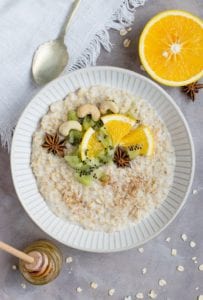Written by Chrystal Moulton, Staff Writer. Fiber intake was associated with low ARG, specifically low abundance of aph3-dprime (aminoglycoside-O-phosphotransferases) and genes associated with multimetal resistance.
 The over prescription of antibiotics is a major contributor to development of antimicrobial resistant strains 1,2. This issue presents a significant burden to treatment of infections as existing antibiotics could offer little therapeutic benefits 3. Furthermore, little investment has been made in creating new antibiotic treatments 4. However, previous research has found diet and lifestyle could also be a significant contributor to antimicrobial resistance. Essentially, antimicrobial resistance is also affected by the gut microbiome 5,6. Genes within the gut microbiome which contribute to antimicrobial resistance are collectively called the human resistome 7. To understand how individuals could lower their risk of contributing to antimicrobial resistant species, researchers in the current study utilized data from the USDA Nutritional Phenotyping study to assess dietary and lifestyle factors predictive of antimicrobial resistance 7.
The over prescription of antibiotics is a major contributor to development of antimicrobial resistant strains 1,2. This issue presents a significant burden to treatment of infections as existing antibiotics could offer little therapeutic benefits 3. Furthermore, little investment has been made in creating new antibiotic treatments 4. However, previous research has found diet and lifestyle could also be a significant contributor to antimicrobial resistance. Essentially, antimicrobial resistance is also affected by the gut microbiome 5,6. Genes within the gut microbiome which contribute to antimicrobial resistance are collectively called the human resistome 7. To understand how individuals could lower their risk of contributing to antimicrobial resistant species, researchers in the current study utilized data from the USDA Nutritional Phenotyping study to assess dietary and lifestyle factors predictive of antimicrobial resistance 7.
Researchers from the United States Department of Agriculture (USDA) Western Human Nutrition Research Center conducted a cross-sectional observational study of healthy people in the general population. In that study, researchers measured the interaction between diet and metabolic response to key hormones, food intake and conversion to energy 8. Researchers in the current trial took data from 290 participants in that metabolic phenotyping trial to evaluate factors contributing to antimicrobial resistance. These participants previously provided stool samples for gene sequencing. Unique sequencing found in stool samples were mapped to an antimicrobial resistant gene database. Participants were separated into quartiles based on amount of antimicrobial resistant gene (ARG) clusters but eventually put into 3 groups: High (quartile 4), medium (quartile 2 & 3), or low (quartile 1). Diet was assessed using data from Food Frequency questionnaires and assessed within each group.
Evaluation of gene sequencing from stool samples showed that aminoglycoside resistance was the most common method of antimicrobial resistance. The second and third abundant mechanism of antimicrobial resistance was macrolide-lincosamide-streptogramin and tetracyclines, respectively. Participants with a low quantity antimicrobial resistant gene (ARG) cluster had an average 46.0 ±3.1RPKG (quartile 1). RPKG indicates reads per kb per genome equivalent and corresponds to the number of gene fragments that code for antibiotic resistance in this study . Participants in the medium and high quantity antimicrobial resistant gene (ARG) cluster groups measured on average 54.7 ±2.7RPKG and 69.2 ±11.3RPKG, respectively. Individuals in the high ARG group had significantly lower diversity in gut microbiome (2,305 ±317) compared to those in both the medium (2,408 ±229) and low (2,423 ±235) ARG groups (p< 0.05). Furthermore, the microbiomes of individuals with low ARG were abundant in different species from the Clostridiaceae family as well as other anaerobic microbes. Diet assessment across the 3 groups showed that individuals in the low ARG group had high fiber intake and consumed different kinds of food compared to the medium and high ARG groups. Logistical analysis showed that the gene aph3-dprime (a gene that initiates antimicrobial resistance) was significantly and negatively associated with intake of soluble fiber.
In summary, researchers found that intake of fiber was associated with low ARG, specifically low abundance of aph3-dprime (aminoglycoside-O-phosphotransferases) and genes associated with multimetal resistance. Further, individuals in the low ARG group had diverse diets that were high in fiber and low in animal protein. More research is needed to confirm these findings.
Source: Oliver, Andrew, Zhengyao Xue, Yirui T. Villanueva, Blythe Durbin-Johnson, Zeynep Alkan, Diana H. Taft, Jinxin Liu et al. “Association of Diet and Antimicrobial Resistance in Healthy US Adults.” Mbio (2022): e00101-22.
Click here to read the full text study.
Posted July 18, 2022.
Chrystal Moulton BA, PMP, is a 2008 graduate of the University of Illinois at Chicago. She graduated with a bachelor’s in psychology with a focus on premedical studies and is a licensed project manager. She currently resides in Indianapolis, IN.
References:
- Pouwels KB, Dolk FCK, Smith DRM, Robotham JV, Smieszek T. Actual versus ‘ideal’ antibiotic prescribing for common conditions in English primary care. The Journal of antimicrobial chemotherapy. Feb 1 2018;73(suppl_2):19-26. doi:10.1093/jac/dkx502
- Van Boeckel TP, Glennon EE, Chen D, et al. Reducing antimicrobial use in food animals. Science. Sep 29 2017;357(6358):1350-1352. doi:10.1126/science.aao1495
- O’Neill J. Review on antimicrobial resistance: tackling drug-resistant infections globally: final report and recommendations. Review on antimicrobial resistance: tackling drug-resistant infections globally: final report and recommendations. 2016;
- WHO. 2019 antibacterial agents in clinical development: an analysis of the antibacterial clinical development pipeline. https://www.who.int/publications/i/item/9789240000193
- Smits SA, Leach J, Sonnenburg ED, et al. Seasonal cycling in the gut microbiome of the Hadza hunter-gatherers of Tanzania. Science. Aug 25 2017;357(6353):802-806. doi:10.1126/science.aan4834
- Wibowo MC, Yang Z, Borry M, et al. Reconstruction of ancient microbial genomes from the human gut. Nature. Jun 2021;594(7862):234-239. doi:10.1038/s41586-021-03532-0
- Oliver A, Xue Z, Villanueva YT, et al. Association of Diet and Antimicrobial Resistance in Healthy US Adults. Mbio. 2022:e00101-22.
- Medicine NULo. USDA Western Human Nutrition Research Center (WHNRC) Cross-Sectional Nutritional Phenotyping Study. https://clinicaltrials.gov/ct2/show/NCT02367287
